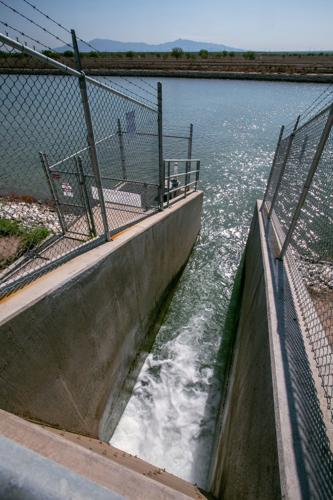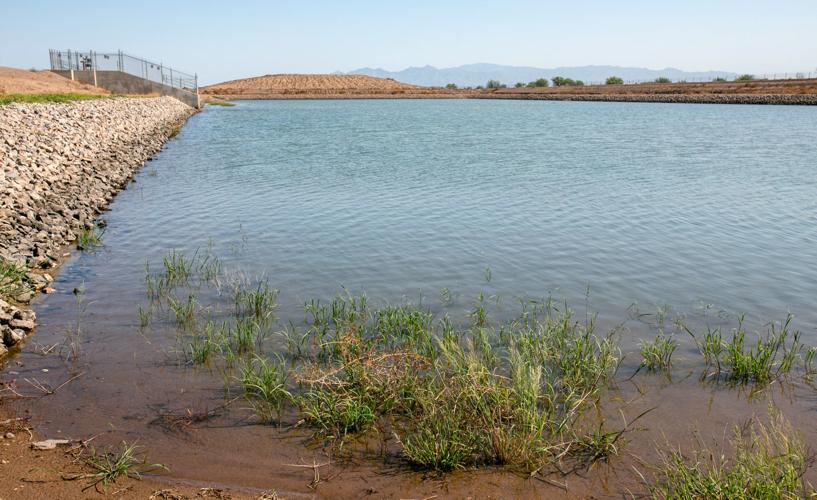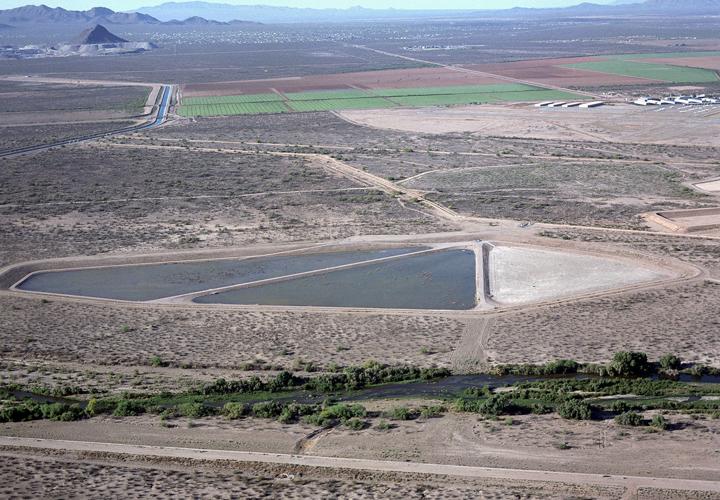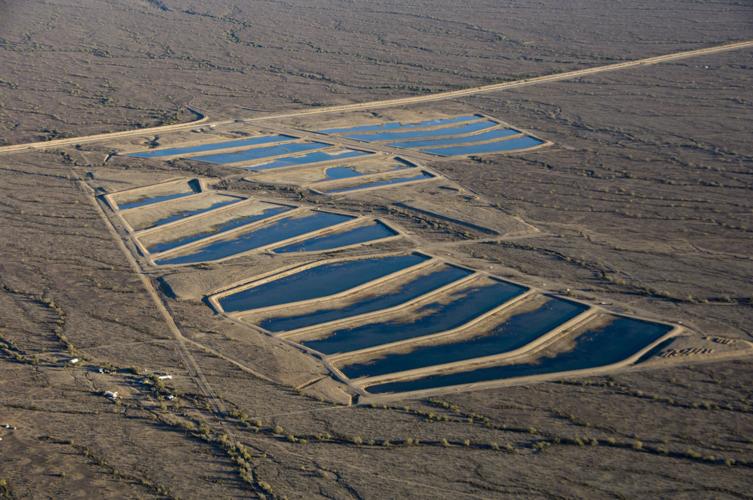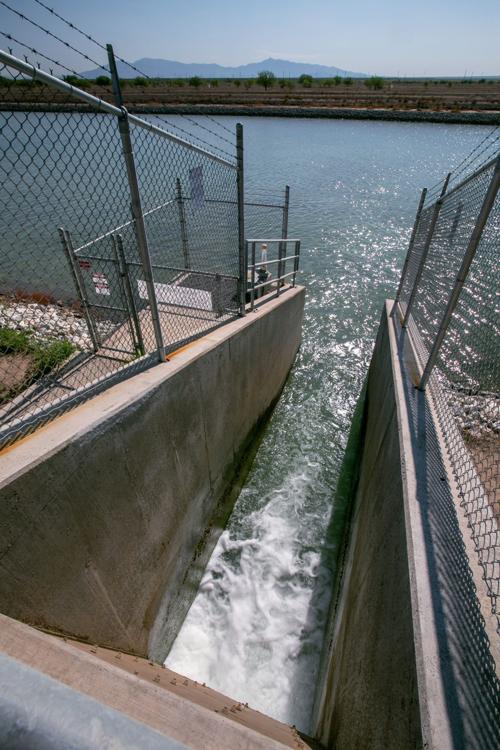By most accounts, the Arizona Water Bank is a monument to foresight and a national model for how to save water for the future. Since the late 1990s, when the Southwest’s 19-year drought first kicked in, authorities here have quietly poured huge amounts of Colorado River water into dozens of large sand and gravel-filled basins until the state is ready to use it.
The total stored is nearly 3.6 million acre-feet of water in 28 sites across Pima, Pinal and Maricopa counties. That’s well over two years worth of CAP deliveries. They’ve stored another 600,000 acre-feet for Nevada.
The total tab has topped $330 million for the state and the Central Arizona Project to design and build storage basins and recharge water in them by artificial means.
But all that work has left a key detail unsettled: how to withdraw the bank’s water when needed.
No wells or other infrastructure exists to pump the water from recharge sites where nearly 25 percent of the water-bank water is stored, including one of the system’s largest recharge facilities. While water is also banked in some of the cotton, alfalfa and grain fields served by CAP water, and they do have infrastructure to get the water out, many of these facilities are far from urban and tribal users.
Unanswered questions
Tucson is better primed than most cities for water-bank recovery. The water bank has put more than two years worth of the city’s water needs into city-owned recharge basins in the Avra Valley, many miles west and northwest of the city limits.
City wells to pump that water out are already in place. But that’s mainly because Tucson Water’s original delivery of CAP water in the 1990s was so problematic that it had to switch to something more innovative and farsighted like recharging its supply. The city first delivered corrosive CAP water that rotted out many homeowners’ pipes. That fiasco led to a citizen-backed initiative requiring the city to recharge CAP water rather than run it through a treatment plant.
But in general, many major questions about water-bank recovery remain unanswered. They include: How, when and where will the water be recovered? Who will recover it? How will this be done legally, meeting contractual obligations? How much will it cost?
The water-bank water is stored mainly for the benefit of Tucson and Phoenix and their suburbs, and tribes such as the Gila River Indian Community and the White Mountain Apache Tribe. (The Tohono O’odham Tribe near Tucson is not in line for water-bank water.) Water users along the Colorado River also have a claim to some of the bank’s water.
There is a recovery plan, done in 2014, but to many city water agencies, it’s longer on concepts than details: “It’s a plan to plan,” says Kathryn Sorensen, the city of Phoenix’s water service director. She is secretary for the Arizona Water Banking Authority’s governing commission, and one of many municipal water officials who has pushed hard for a more thorough plan.
“I understand why it was written that way, to provide maximum flexibility. We aren’t sure when shortages will come. Many things could change in a short period of time. But there is a trade-off. What cities need is certainty,” Sorensen said.
The 2014 plan reflects the longstanding, conventional wisdom that CAP cutbacks to cities and tribes wouldn’t start until the mid-2030s at the earliest.
Today, the outlook for Lake Mead and the river in general is worse. Shortages cutting off agricultural water are expected in the early 2020s. Urban shortages are considered possible by the mid-2020s and maybe even 2022, under the worst-case, least-likely scenario.
So water officials are now grappling with the nitty-gritty details of putting together a more complete recovery plan, perhaps by the end of 2018.
The effort is being led by a committee representing various water utilities and other interests, and shepherded by the Central Arizona Water Conservation District, which runs CAP, the Arizona Department of Water Resources and the Arizona Water Banking Authority, which manages the water bank.
Wally Wilson, water service manager for the suburban Metro Water district, said that the big questions about recovery weren’t addressed before, “to the chagrin of many.”
“There was the hope back in 2014 that a plan would be a complete plan: What are the risks? How are we going to address them? When do we need to start implementing this?” Wilson said.
Ken Seasholes, CAP’s resource planning manager, has no doubt that the latest planning effort will succeed, since water-bank recovery is in everyone’s interest. He sees “a lot of overlap” between what cities have proposed and what state and regional agencies have lined up.
It’s “a matter of working through challenges. We’ve heard loud and clear, from cities particularly, that they want better clarity for decision making,” he said.
“Water-bank recovery is one of major strategies this state has adopted to mitigate impacts of a river shortage,” he said.
Hoping Seasholes is right is Warren Tenney, a former Metro Water general manager and CAP board member, and now director of the Arizona Municipal Water Users Association, representing 10 Phoenix-area cities. Tenney, a Boy Scout while growing up, said, “I believe that we will be ready, but it’s important that we push hard because as a scout, I believe it’s important to be prepared.”
Also, the water bank won’t be a total bailout. Cities and tribes probably won’t get more than 20 percent of the water they lose each year from shortages. That number is not etched in a formal document, but it’s accepted by most parties involved.

The $7.8 million Pima Mine Road Recharge Project, which has five basins, is 15 miles south of Tucson. Water gushes into this basin from an underground vault. Then, it seeps into loosely packed sands and gravels underneath.
Success and uncertainty
Two faces of the water bank lie nearly 200 miles apart, in the deserts south of Tucson and west of Phoenix.
A likely success story is CAP’s $7.8 million Pima Mine Road Recharge Project, containing five basins, totaling 37 acres, about a mile and a half east of Interstate 19. Last week, the Star and Arizona Public Media visited one basin, elongated and rectangular-shaped, looking like a giant swimming pool, surrounded by desert. It is 15 miles south of Tucson, and 2.5 miles east of where CAP’s underground steel pipelines end the project’s 336-mile run from the Colorado River.
Water gushes into this basin from an underground vault. Then, it seeps into loosely packed sands and gravels underneath, materials that CAP officials say made this an ideal geologic recharge spot The water infiltrates at about 3 to 5 feet per day, taking about 10 days to reach the aquifer.
It’s the only one of CAP’s six recharge sites with significant infrastructure nearby — a city well field less than a mile away.
So when it’s time to get this water, drilling wells presumably won’t be a major expense if it’s needed at all.

Tonopah Desert Recharge Project in Tonopah, about 65 miles west of Phoenix.
The same can’t be said for the $19.8 million Tonopah Desert Recharge Project, whose 19 basins are spread over 542 acres, 65 miles west of Phoenix. It’s massive enough to store 25 percent more CAP water than the project delivers in a year. But it’s had big-time problems.
With three sets of low-slung mountains to its west, Tonopah’s key connection to civilization is CAP’s concrete canal, adjoining 19 recharge basins. That proximity, plus what was seen as favorable geology, made it an attractive location to water planners when Tonopah was permitted by the state for recharge in 2005.
To date, about 806,000 acre-feet of Colorado River water has been stored there, including 479,000 for the water bank. Twenty entities, including cities, an Indian tribe, private water companies, a mining company and the CAP have permits to store water there.
But officials also have known since 2006 that the area’s groundwater — with which the recharged Colorado River water mixes — has levels of arsenic and fluoride exceeding federal EPA drinking water limits. In 2015, a CAP consultant, Montgomery and Associates, pegged the price tag for treating and recovering Tonopah’s water at $143 million to $200 million.
In 2015, the Central Arizona water district halted water deliveries to Tonopah until further notice. That was partly because deliveries to the water bank have dropped in general in recent years as CAP was leaving some water behind in Lake Mead.
Also, “there is a general opinion that the other CAWCD recharge projects, closer to customer service areas, are a more desirable location” for storing project water, said a 2017 report for the water district.
Last winter, preliminary results of additional testing at Tonopah were even more unfavorable.
First, the aquifer underneath the recharge basin is substantially less permeable below 300 feet than previously thought. Second, concentrations of arsenic and fluoride in natural groundwater are larger than previously estimated, said CAP consulting firm Montgomery and Associates. That means total costs to recover the water over 26 years could be much higher than previously thought, the consultants said.
Now, the district is preparing to hire a consultant to evaluate alternative sites for large-scale recovery of water in that area. A report on alternatives is due for public release in early 2019.
For longtime CAP board member Sharon Megdal and former ADWR director Kathy Ferris, what happened at Tonopah is a symptom of what can go wrong because Arizona concentrated on recharging the bank water without enough planning for how to get the water out.
Both recall having spoken to top CAP officials — Megdal in the late 1990s and Ferris in the early 2010s — about the need to plan more thoroughly for recovery and having their concerns rebuffed.
“Tonopah was viewed as attractive, with proximity to wells and a self-contained recharge project, but they didn’t do the in-depth recovery analysis” back then, Megdal recalled. Had officials originally conducted the kind of analysis done more recently by Montgomery and Associates, “maybe, just maybe, they wouldn’t have put 400,000 acre-feet in there” for the water bank.
Ferris recalled being “stunned” when she started attending water-bank commission meetings after taking over as director of the Phoenix-area water users association in 2012, and learned that there was no recovery plan.
“We don’t know exactly when a shortage will hit. Cities are in the business of providing water 365 days a year. The water bank is only as good as the system you have to make that water available,” Ferris said.
CAP’s Seasholes declined to comment on allegations that the agency failed to get going on recovery planning sooner because it didn’t think it was necessary. But he said that “recovery has been a consideration of water banking” since the bank’s creation, and it was considered as part of the initial feasibility studies of the Tonopah site.
“We’re doing the appropriate level of planning today, based on the circumstances we see before us,” he said.

The Lower Santa Cruz River recharge site for the water bank sits in the Marana area.
Getting to the water
Now, the big question is how to retrieve also this water, or should it be retrieved at all?
A direct but pricey route would be to drill wells and lay pipelines to pump out the recharged water and put it into the CAP canal to ship to cities and tribes.
That’s what Tucson is already prepared to do. Three northwest-side water providers — Oro Valley, Marana and Metro Water — also are preparing to build infrastructure to take water-bank water that’s been stored underground. By 2023, they hope wells and pipelines will be in place at a cost of $30 million to recover that and their own CAP water that’s also been stored underground for years.
CAP, however, says it doesn’t expect to conduct direct recovery from most of its water-bank sites, at least not soon, and that most of its facilities were never intended for direct recovery.
Direct recovery “is one of the most costly ways to achieve recovery,” Seasholes said. “It’s quite costly compared to using wells elsewhere that are underutilized, or requiring reinvestment.”
CAP prefers a less expensive option called “indirect recovery.” That would have CAP enlist cities as “recovery partners.” Then, water-bank water remains in the ground.
Cities would use their wells to extract more of their own water supplies. The water-bank water would give the cities “credits,” or pumping rights to their groundwater in quantities that otherwise wouldn’t be allowed under state law. In exchange, the cities would get less pure CAP water.
But among Maricopa County cities, “there has been a strong desire … for wet water to meet wet water needs,” Metro’s Wilson said. “They don’t want to do paper water.”
Wilson and other urban officials are concerned that if they pump out too much of their own water, their aquifers will be depleted.
But in many cases, cities and other water users have wells close to the water-bank areas, making that pumping a feasible option, CAP’s Seasholes counters.
As for the water stored in farms, Megdal says there’s a big question mark about how that would be recovered, since there aren’t city well fields near most farms. That’s particularly true because once shortages begin, farms will want to start pumping more groundwater, putting them in competition with cities for the water stored underground, said Megdal.
But in Pinal County at least, where much of that water is stored, the bulk of what’s being kept there is not for future use by cities, so there won’t be a problem for cities to get to it, CAP spokeswoman DeEtte Person said. While Megdal’s point about competition for this water is fair, in some cases, these farm-storage areas anticipate having enough well capacity to be used for both water-bank recovery and daily irrigation needs, Person said.
One example Person cites of a good recovery prospect is at Roosevelt Water Conservation District east of Phoenix, with whom the CAP district recently signed an agreement to recover 10,000 acre-feet of water-bank water each year.
The recovery will tap from some of the 40 existing wells owned by the Roosevelt district, which serves farms with irrigation water. The district’s canal system connects with CAP’s aqueduct and other canal systems for transfer during shortages to the Gila River Indians, CAP says.
“We believe there will be a mix of methods. That’s part of the reason we’re doing a study of recovery,” Seasholes said.
“Recovery is a complex undertaking, but the work done in recent years, including joint planning and initial recovery agreements, make it clear that with partnerships and cooperation, recovery can be accomplished in a cost-effective manner.”
Ready on time?
The bottom line for the water bank is: Will it be ready to deliver water to Central and Southern Arizona when it’s needed in times of shortage?
The general consensus among most experts is yes, with one caveat. If Arizona, California and Nevada can agree on a multistate Drought Contingency Plan to leave more of their Colorado River water in Lake Mead, that will delay the time of very serious shortages for many years. That gives time to plan recovery before the crunch hits.
But if the drought plan doesn’t go through, Lake Mead levels could crash much sooner, forcing cutbacks before the water bank is ready to fully respond, said Megdal and Susanna Eden, director and deputy director of the University of Arizona’s Water Resources Research Center. Both have co-authored separate, detailed papers about the water bank.
Yet Sorensen and Megdal remain optimistic that the water bank will work. Even if the bank isn’t ready when first needed, cities and towns can pump water from their own wells until the water bank is ready, Megdal said.
“One thing we know when it comes to water, Arizonans are very innovative,” Sorensen said. “There are a lot of difficulties and a lot of uncertainties. But I know we’ll get there.”


